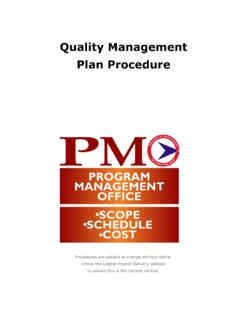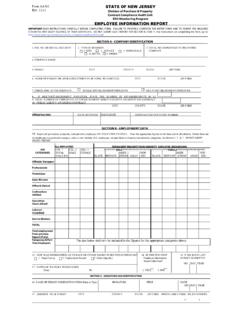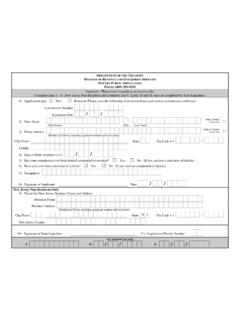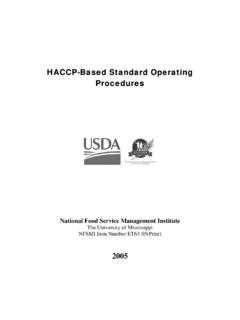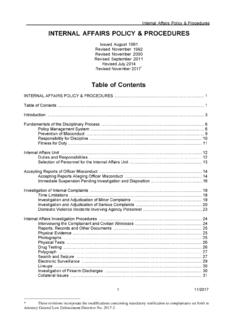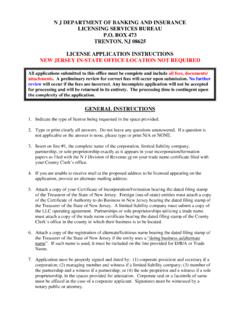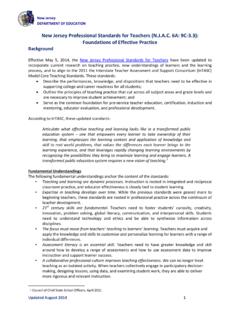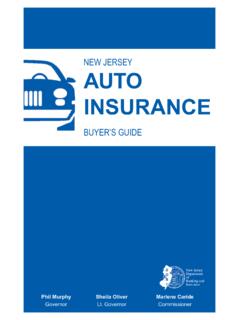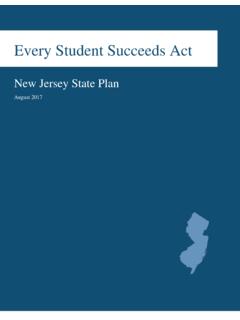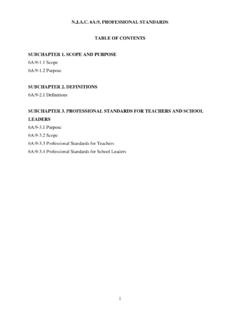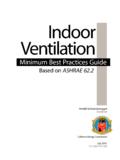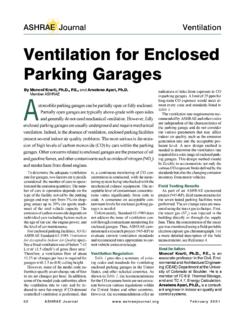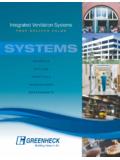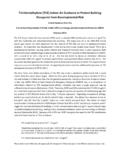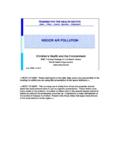Transcription of CHAPTER 100. SAFETY AND HEALTH STANDARDS …
1 TITLE 12. DEPARTMENT OF LABOR CHAPTER 100. SAFETY AND HEALTH STANDARDS FOR public EMPLOYEES subchapter 13. indoor AIR QUALITY STANDARD 12 (2007) 12 Scope This subchapter shall apply to matters relating to indoor air quality in buildings occupied by public employees during regular work hours. 12 Definitions The following words and terms, when used in this subchapter , have the following meaning unless the context clearly indicates otherwise. "Air contaminants" refers to substances contained in the vapors from paint, cleaning chemicals, pesticides, solvents, particulates, outdoor air pollutants and other airborne substances which together may cause material impairment to em-ployees working within the enclosed workplace.
2 "Building-related illness" describes specific medical conditions of known etiology which can be documented by physical signs and laboratory findings. Such illnesses include sensory irritation when caused by known agents, respira-tory allergies, asthma, nosocomial infections, humidifier fever, Legionnaires' disease, and the signs and symptoms char-acteristic of exposure to chemical or biologic substances such as carbon monoxide, formaldehyde, pesticides, endotox-ins, or mycotoxins. "Building systems" includes the heating, ventilation and air-conditioning (HVAC) system, the energy management system and all other systems in a facility which may impact indoor air quality.
3 "Department" means the Department of HEALTH and Senior Services. "Designated person" means a person who has been given the responsibility by the employer to take necessary measures to assure compliance with this subchapter . " employee " means the term as defined at 12 "Employer" means the term as defined at 12 "HVAC system" means the collective components of the heating, ventilation and air-conditioning system including, but not limited to, filters and frames, cooling coil condensate drip pans and drainage piping, outside air dampers and actuators, humidifiers, air distribution ductwork, automatic temperature controls, and cooling towers.
4 "HVAC System Commissioning Report" means a document normally prepared by an architect or engineer that provides verification that the HVAC system is operating in conformity with the design intent. "Office building" means a building in which administrative, clerical or educational activities are conducted. Exam-ples of facilities and/or operations, which are not office buildings, include repair shops, garages, print shops and ware-houses. "Renovation and remodeling" means building modification involving activities that include but are not limited to: removal or replacement of walls, roofing, ceilings, floors, carpet, and components such as moldings, cabinets, doors, and windows; painting; decorating; demolition; surface refinishing; and removal or cleaning of ventilation ducts.
5 "Sick Building Syndrome" describes a situation in which a workplace is characterized by a substantial number of building occupants experiencing HEALTH and comfort problems that can be related to working indoors. Additionally the reported symptoms do not fit the pattern of any particular illness, are difficult to trace to any specific source and relief from these symptoms occurs upon leaving the building. It is important to distinguish Sick Building Syndrome from problems of building-related illness. The latter term is reserved for situations in which signs and symptoms of diagnos-able illness are identified and can be attributed directly to specific airborne contaminants.
6 12 Compliance program (a) The employer shall identify a designated person who is given the responsibility to assure compliance with this section. The employer shall assure that the designated person is familiar with the requirements of this subchapter . The designated person shall assure that at least the following actions are implemented and documented: 1. Establishing and following a preventive maintenance schedule in accordance with the manufacturer's recommen-dations or with accepted practice for the HVAC system.
7 Scheduled maintenance of the HVAC system shall include checking and/or changing air filters, checking and/or changing belts, lubrication of equipment parts, checking the func-tioning of motors and confirming that all equipment is in operating order. Damaged or inoperable components shall be replaced or repaired as appropriate. Additionally, any parts of this system with standing water shall be checked visually for microbial growth; 2. Implementing the use of general or local exhaust ventilation where housekeeping and maintenance activities in-volve use of equipment or products that could reasonably be expected to result in hazardous chemical or particulate ex-posures, above the applicable Permissible Exposure Limit (PEL), as adopted by reference under 12 , to employees working in other areas of the building or facility; 3.
8 When the carbon dioxide level exceeds 1,000 parts per million (ppm), the employer shall check to make sure the HVAC system is operating as it should. If it is not, the employer shall take necessary steps as outlined in (a)1 above; 4. When temperatures in office buildings are outside of the range of 68 to 79 degrees Fahrenheit, the employer shall check to make sure the HVAC system is in proper operating order. If it is not, the employer shall take necessary steps as outlined in (a)1 above; 5. If contamination of the make-up air supply is identified and documented, then the make-up inlets and/or exhaust air outlets shall be relocated or the source of the contamination eliminated.
9 Sources of make-up air contamination may include contaminants from sources such as, but not limited to, cooling towers, vents, and vehicle exhaust; 6. Assuring that building without mechanical ventilation are maintained so that windows, doors, vents, stacks and other portals designed or used for natural ventilation are in operable condition; 7. Promptly investigating all employee complaints of signs or symptoms that may be associated with building-related illness or sick building syndrome; 8. The employer shall have a written plan describing how it will achieve compliance with this subchapter , which plan shall list the identity and responsibilities of the designated person referred to in (a) above and which shall include procedures which, at a minimum, address the following issues: i.
10 Following of a preventive maintenance schedule; ii. Keeping of required records; iii. Locating of indoor Air Quality compliance documents; iv. Investigating of employee complaints; v. Responding to signed employee complaints that have been submitted to the State alleging violation of the public Employees' Occupational SAFETY and HEALTH Act, 34:6A-25 et seq.; vi. Notifying employees of work that may introduce air contaminants; vii. Controlling microbial contamination; viii. Controlling air contaminants; ix.
